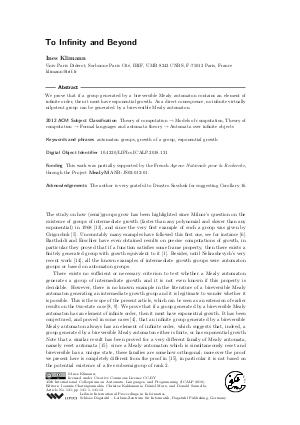To Infinity and Beyond
Author Ines Klimann
-
Part of:
Volume:
45th International Colloquium on Automata, Languages, and Programming (ICALP 2018)
Part of: Series: Leibniz International Proceedings in Informatics (LIPIcs)
Part of: Conference: International Colloquium on Automata, Languages, and Programming (ICALP) - License:
 Creative Commons Attribution 3.0 Unported license
Creative Commons Attribution 3.0 Unported license
- Publication Date: 2018-07-04
File

PDF
LIPIcs.ICALP.2018.131.pdf
- Filesize: 395 kB
- 12 pages
Document Identifiers
Subject Classification
ACM Subject Classification
- Theory of computation → Models of computation
- Theory of computation → Automata over infinite objects
Keywords
- automaton groups
- growth of a group
- exponential growth
Metrics
- Access Statistics
-
Total Accesses (updated on a weekly basis)
0Document
0Metadata
Abstract
We prove that if a group generated by a bireversible Mealy automaton contains an element of infinite order, then it must have exponential growth. As a direct consequence, no infinite virtually nilpotent group can be generated by a bireversible Mealy automaton.
Cite As Get BibTex
Ines Klimann. To Infinity and Beyond. In 45th International Colloquium on Automata, Languages, and Programming (ICALP 2018). Leibniz International Proceedings in Informatics (LIPIcs), Volume 107, pp. 131:1-131:12, Schloss Dagstuhl – Leibniz-Zentrum für Informatik (2018)
https://doi.org/10.4230/LIPIcs.ICALP.2018.131
BibTex
@InProceedings{klimann:LIPIcs.ICALP.2018.131,
author = {Klimann, Ines},
title = {{To Infinity and Beyond}},
booktitle = {45th International Colloquium on Automata, Languages, and Programming (ICALP 2018)},
pages = {131:1--131:12},
series = {Leibniz International Proceedings in Informatics (LIPIcs)},
ISBN = {978-3-95977-076-7},
ISSN = {1868-8969},
year = {2018},
volume = {107},
editor = {Chatzigiannakis, Ioannis and Kaklamanis, Christos and Marx, D\'{a}niel and Sannella, Donald},
publisher = {Schloss Dagstuhl -- Leibniz-Zentrum f{\"u}r Informatik},
address = {Dagstuhl, Germany},
URL = {https://drops.dagstuhl.de/entities/document/10.4230/LIPIcs.ICALP.2018.131},
URN = {urn:nbn:de:0030-drops-91359},
doi = {10.4230/LIPIcs.ICALP.2018.131},
annote = {Keywords: automaton groups, growth of a group, exponential growth}
}
Author Details
Funding
This work was partially supported by the French Agence Nationale pour la Recherche, through the Project MealyM ANR-JS02-012-01.
References
-
L. Bartholdi and A. Erschler. Groups of given intermediate word growth. Ann. Inst. Fourier, 64(5):2003-2036, 2014.

-
T. Brough and A.J. Cain. Automaton semigroups: New constructions results and examples of non-automaton semigroups. Theoretical Computer Science, 674:1-15, 2017.

- C. Drutu and M. Kapovich. Lectures on geometric group theory. URL: https://www.math.ucdavis.edu/~kapovich/EPR/ggt.pdf.
-
Th. Godin and I. Klimann. On bireversible Mealy automata and the Burnside problem. Theoretical Computer Science, 707:24-35, 2018.

-
R. Grigorchuk. Degrees of growth of finitely generated groups and the theory of invariant means. Izv. Akad. Nauk SSSR Ser. Mat., 48-5:939-985, 1984.

-
R. Grigorchuk. Degrees of growth of finitely generated groups, and the theory of invariant means. Mathematics of the USSR-Izvestiya, 25(2):259, 1985.

-
R. Grigorchuk and I. Pak. Groups of intermediate growth: an introduction. L'Enseignement Mathématique, 54(3-4):251-272, 2008.

-
R.I. Grigorchuk. On periodic groups generated by finite automata. In 18-th USSR Algebraic Conference, Kishinev, 1985.

-
I. Klimann. Automaton semigroups: The two-state case. Theor. Comput. Syst. (special issue STACS'13), pages 1-17, 2014.

-
I. Klimann. On level-transitivity and exponential growth. Semigroup Forum, 95(3):441-447, 2016.

-
I. Klimann, M. Picantin, and D. Savchuk. A connected 3-state reversible Mealy automaton cannot generate an infinite Burnside group. In DLT' 15, volume 9168 of LNCS, pages 313-325, 2015.

-
A. Mann. How groups grow, volume 395 of Lecture Note Series. The London Mathematical Society, 2012.

-
J. Milnor. Advanced problem 5603. MAA Monthly, 75:685-686, 1968.

-
V. Nekrashevich. Palindromic subshifts and simple periodic groups of intermediate growth. Annals of Mathematics, 187(3):667-719, 2018.

-
F. Olukoya. The growth rates of automaton groups generated by reset automata. arXiv:1708.07209, 2017.

-
J.A. Wolf. Growth of finitely generated solvable groups and curvature of riemanniann manifolds. J. Differential Geom., 2(4):421-446, 1968.

